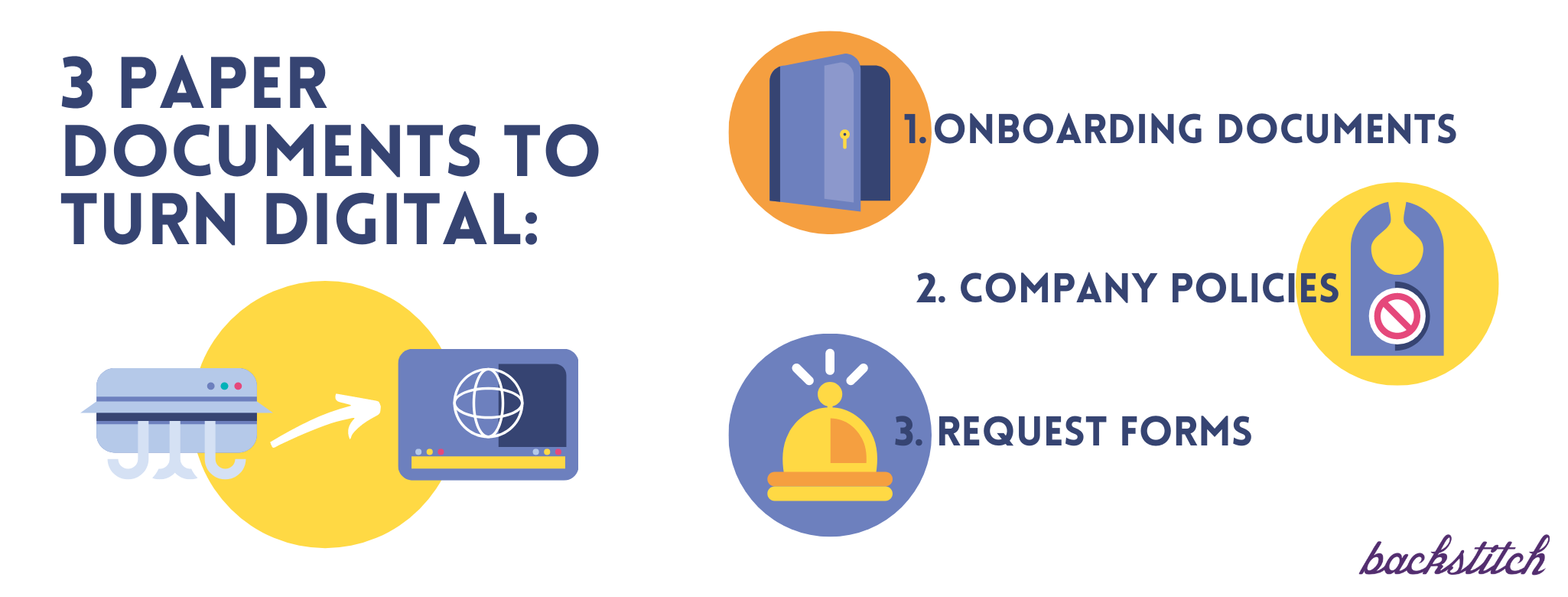There are countless studies revealing the benefits of transitioning into a paperless workplace. Despite the measured benefits, 21 percent of HR departments still actively resist this transition by using paper for their processes.
Like any goal, it is much easier to accomplish a paperless workplace if you do it gradually. After all, you can’t expect the average office to go from using 10,000 sheets of paper a year to zero right away. Instead, you should make a goal of lowering paper usage by about 15 to 20 percent each month until you eventually get down to no paper use at all.
Make a goal of lowering your paper usage by 15-20% each month
To eliminate your company’s paper usage, we recommend getting started by targeting the following types of employee documents.

1. Onboarding Documents
A lot of the onboarding process is spent trying to get employees to read and sign documents. A vast majority of these documents are often printed off, with only a small fraction of them even requiring signatures. For this reason, onboarding documents are the perfect place to start transitioning into a paperless office.
When documents do require a signature, electronic signature documentation allows you to avoid ever needing to print off a single piece of paper. Simply upload the onboarding documents onto the computer and then turn the signature boxes into electronic signature boxes. You can then email these to new employees, have them sign on their computer or smartphone, and then email it back to you.
Your organization will also now have an electronic filing system for these previously physical pieces of paper. It eliminates the need for boxes and cabinets of tens or hundreds of sheets per employee. The HR office can be streamlined, providing a more comfortable space for your human resource team.
2. Company Policies
A new office policy, whether it is anti-harassment, biometric consent, intellectual property, or some other type, will often be a lengthy piece of writing filled with legal jargon. These are usually multi-page documents that need to be handed out to every employee. They are often big contributors to company paper usage, taking valuable resources to print, store and send. Yet, due to the valuable information they provide, total elimination is not an option.
Thanks to employee apps, it is incredibly easy to make this a completely electronic process. You just need to upload the files onto a section of the employee app that is designed to hold important workplace documents. Afterwards, message everyone so they know that a new policy has been uploaded to the app, and there is an easy way to access it.
Another benefit of offering a digital platform for company policies is having the ability to utilize search shortcuts and access information easier. Physical copies of documents can be messy and unorganized which can lead to lost information and gaps of knowledge.
Provide an option to put these documents on a virtual platform to allow employees to store the files in an organized place. It also makes it simple to directly search for specific information within the documents, improving the user experience. This saves time and space allowing employees to focus more of their energy on their work.
3. Request Forms
A lot of workplaces require employees to fill out physical forms and hand them in to their manager or HR department when they want to do things like make a medical claim or request vacation days. Not only does paper take up space, it requires someone to also physically transport the documents to the correct recipient.
With a digital system, all it takes is a simple online system where employees can sign into the company website with their employee credentials or jump onto the employee app to then submit their request forms without ever needing to touch a single sheet of paper. The effectiveness easily compounds with organizations over 30 or 40 employees.
If you want to reap the various benefits that come from being a paperless workplace, then make sure that you start the transition with these types of employee documentation. If you need help optimizing your internal communications at any point contact us at backstitch!
Interested in learning how backstitch can help your company go paperless?

